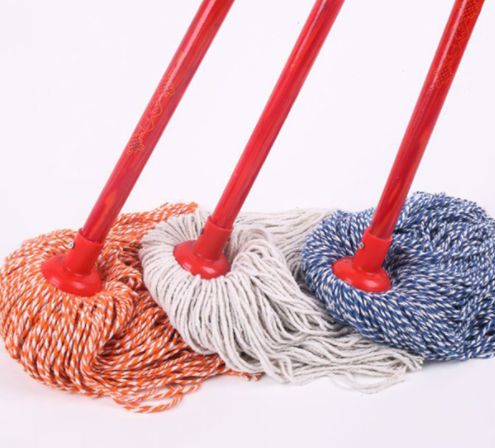The mop has evolved significantly over time, with various innovations and improvements shaping its design and functionality. Here’s a brief overview of the evolution of the mop:
- Early Mops (Early 19th Century): The earliest mops were simple bundles of rags or pieces of fabric attached to a stick or handle. They were used for basic floor cleaning, but they were not very efficient or durable.
- Yarn Mops (Mid-19th Century): In the mid-19th century, yarn mops started to gain popularity. Yarn mops were made from strands of cotton or other materials, which allowed for better absorbency and cleaning capabilities.
- Sponge Mops (Early 20th Century): In the early 20th century, sponge mops were introduced. These mops featured a sponge head that could absorb and hold more water and cleaning solution, making them more effective for cleaning large areas.
- String Mops (Mid-20th Century): String mops, also known as cotton mops, became popular in the mid-20th century. They featured long, thick strings made of cotton or synthetic fibers, providing better durability and cleaning efficiency.
- Mop Buckets with Wringers (Mid-20th Century): In the mid-20th century, mop buckets with built-in wringers were introduced. This innovation made it easier to control the moisture level of the mop head, allowing for more efficient cleaning and reducing the need for manual wringing.
- Microfiber Mops (Late 20th Century): Microfiber mops were introduced in the late 20th century and became a significant advancement in mop technology. Microfiber is highly absorbent and can capture and hold onto dirt and debris more effectively than traditional fibers.
- Steam Mops (Late 20th Century): Steam mops emerged in the late 20th century, using hot steam to clean and sanitize floors without the need for chemical cleaners. They are effective in killing germs and bacteria, making them popular for households with children and pets.
- Spray Mops (21st Century): Spray mops, featuring a built-in spray bottle for cleaning solution, gained popularity in the 21st century. They eliminated the need for a separate bucket, making mopping more convenient and time-saving.
- Smart Mop Technology (21st Century): In recent years, smart mop technology has started to emerge. These mops may include automatic water dispensing, sensors to detect dirt, and even robotic mops that can clean floors autonomously.
The evolution of the mop has been driven by the desire for more effective and convenient cleaning tools. From simple rags on sticks to advanced microfiber and smart technology, mops continue to evolve to meet the needs of modern cleaning demands.








